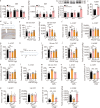Hippocampal PACAP signaling activation triggers a rapid antidepressant response
- PMID: 39044298
- PMCID: PMC11265467
- DOI: 10.1186/s40779-024-00548-1
Hippocampal PACAP signaling activation triggers a rapid antidepressant response
Abstract
Background: The development of ketamine-like rapid antidepressants holds promise for enhancing the therapeutic efficacy of depression, but the underlying cellular and molecular mechanisms remain unclear. Implicated in depression regulation, the neuropeptide pituitary adenylate cyclase-activating polypeptide (PACAP) is investigated here to examine its role in mediating the rapid antidepressant response.
Methods: The onset of antidepressant response was assessed through depression-related behavioral paradigms. The signaling mechanism of PACAP in the hippocampal dentate gyrus (DG) was evaluated by utilizing site-directed gene knockdown, pharmacological interventions, or optogenetic manipulations. Overall, 446 mice were used for behavioral and molecular signaling testing. Mice were divided into control or experimental groups randomly in each experiment, and the experimental manipulations included: chronic paroxetine treatments (4, 9, 14 d) or a single treatment of ketamine; social defeat or lipopolysaccharides-injection induced depression models; different doses of PACAP (0.4, 2, 4 ng/site; microinjected into the hippocampal DG); pharmacological intra-DG interventions (CALM and PACAP6-38); intra-DG viral-mediated PACAP RNAi; and opotogenetics using channelrhodopsins 2 (ChR2) or endoplasmic natronomonas halorhodopsine 3.0 (eNpHR3.0). Behavioral paradigms included novelty suppressed feeding test, tail suspension test, forced swimming test, and sucrose preference test. Western blotting, ELISA, or quantitative real-time PCR (RT-PCR) analysis were used to detect the expressions of proteins/peptides or genes in the hippocampus.
Results: Chronic administration of the slow-onset antidepressant paroxetine resulted in an increase in hippocampal PACAP expression, and intra-DG blockade of PACAP attenuated the onset of the antidepressant response. The levels of hippocampal PACAP expression were reduced in both two distinct depression animal models and intra-DG knockdown of PACAP induced depression-like behaviors. Conversely, a single infusion of PACAP into the DG region produced a rapid and sustained antidepressant response in both normal and chronically stressed mice. Optogenetic intra-DG excitation of PACAP-expressing neurons instantly elicited antidepressant responses, while optogenetic inhibition induced depression-like behaviors. The longer optogenetic excitation/inhibition elicited the more sustained antidepressant/depression-like responses. Intra-DG PACAP infusion immediately facilitated the signaling for rapid antidepressant response by inhibiting calcium/calmodulin-dependent protein kinase II (CaMKII)-eukaryotic elongation factor 2 (eEF2) and activating the mammalian target of rapamycin (mTOR). Pre-activation of CaMKII signaling within the DG blunted PACAP-induced rapid antidepressant response as well as eEF2-mTOR-brain-derived neurotrophic factor (BDNF) signaling. Finally, acute ketamine treatment upregulated hippocampal PACAP expression, whereas intra-DG blockade of PACAP signaling attenuated ketamine's rapid antidepressant response.
Conclusions: Activation of hippocampal PACAP signaling induces a rapid antidepressant response through the regulation of CaMKII inhibition-governed eEF2-mTOR-BDNF signaling.
Keywords: Antidepressant response; Ketamine; Novelty suppressed feeding (NSF); Optogenetic; Pituitary adenylate cyclase-activating polypeptide (PACAP).
© 2024. The Author(s).
Conflict of interest statement
The authors declare that they have no competing interests.
Figures







References
MeSH terms
Substances
Grants and funding
LinkOut - more resources
Full Text Sources
Medical
Molecular Biology Databases
Miscellaneous

